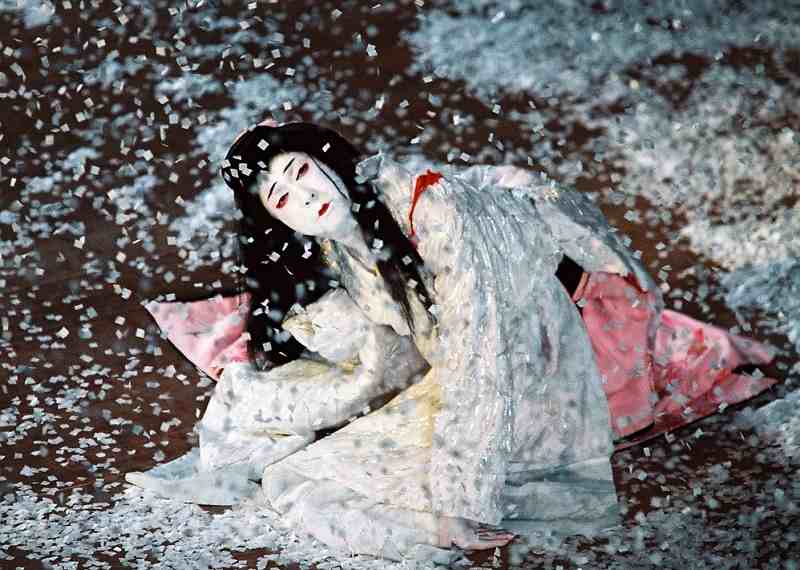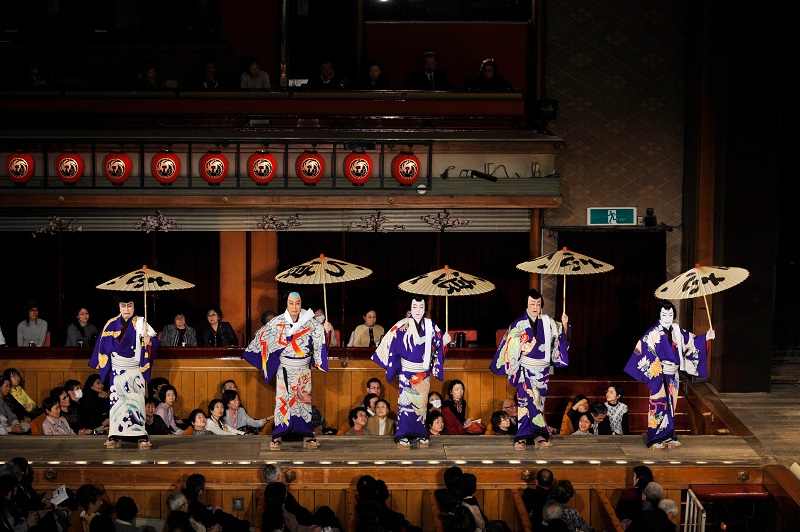
“Kurumabiki” (“Pulling the Carriage Apart”)
7:00 JST, December 11, 2022
Taking kabuki on tour overseas again will take some time, but a new service is streaming the performances to personal computers in select areas abroad.
Kabuki production company Shochiku Co. has launched Kabuki On Demand for overseas audiences. Previously, the company streamed kabuki performances for overseas viewers for a limited time, but this is the first time it is doing so on a continuous basis.
The streaming service began in 2020 for the domestic market, with overseas streaming beginning on Nov. 1, 2022, for nine places: Australia, Canada, France, Germany, Italy, Spain, Taiwan, the United Kingdom and the United States. Fees currently range from ¥800 to around ¥1,000 per performance and the service is only available for PCs.
Kabuki expert Helen Parker of the University of Edinburgh welcomed the increased opportunities for viewers outside Japan to experience the theatrical works amid the prolonged novel coronavirus outbreak.
“As an online, on-demand video-streaming service, it is much more accessible than the resources we’ve been able to use so far,” she said, citing DVDs being expensive and hard to obtain outside Japan.
Three works have been prepared for the overseas launch, featuring different styles and tastes. Parker said these works will satisfy not only those who are familiar with kabuki, but also those who are seeing it for the first time.

“Sagi Musume” (“Heron Maiden”)
“Sagi Musume” (“Heron Maiden”) is a famed dance performed by an onnagata, an actor in the all-male world of kabuki who plays a female character. This version is from Shochiku’s Cinema Kabuki series shown in movie theaters and stars the acclaimed Bando Tamasaburo, who has a following overseas as well. English subtitles are provided.
“Kurumabiki” (“Pulling the Carriage Apart”) is a famous scene from the play “Sugawara and the Secrets of Calligraphy.” Based on the historical figure Sugawara no Michizane, the play is originally in five acts. It premiered as bunraku puppet theatre in August 1746, before becoming a kabuki play a month later. This version features the popular Nakamura Kichiemon and other stars. Secondary audio in English is available.
Two particularly popular scenes from “Benten Musume Meo no Shiranami” (“The Five Thieves”) form the third work being streamed. The scenes are “The Hamamatsuya Textile Shop,” in which an intriguing revelation is made, and “The Gathering along the Inase River Bank” where the five thieves appear together. This version stars renowned veteran actors including Onoe Kikugoro. English is on the secondary audio.

“Benten Musume Meo no Shiranami” (“The Five Thieves”)
Streaming for “Carriage” and “Thieves” is available through Oct. 31, 2023, while no end date has been decided for “Heron Maiden.”
Based on the response from Kabuki On Demand users to these works, Shochiku will consider future performances to make available.
“The novel coronavirus pandemic was a major turning point in the launch of the on-demand service,” said Shochiku’s Managing Director Naoto Funakoshi. “The pandemic put kabuki performances at the Kabukiza Theatre in Tokyo and other venues on hold, and revenue was severely impacted.”
In the past, there were some senior kabuki actors who were reluctant about having kabuki offered online, but with the COVID-19 pandemic preventing live performances, they have changed their mindset in order to bring kabuki to their fans.
“Even on the actors’ side,” Funakoshi said, “there is now a deeper understanding of the significance of video distribution of kabuki.”
Kabuki has been performed overseas since a visit to the Soviet Union in 1928. By 2019, kabuki had been performed about 120 times in about 100 cities around the world, including London, New York and Paris.
As a sort of traveling ambassador, kabuki has played a role in cultural exchange by transmitting traditional Japanese culture overseas.
Since the pandemic started, however, overseas performances have remained suspended. Now that the infection situation has begun to be manageable, there is finally talk of resuming overseas tours.
“I still want people to see live performances in theaters,” Funakoshi said. “But the spread of the internet and innovations in digital technology are expanding dreams.”
The three works currently being streamed were performed at the Kabukiza Theatre in either 2005 or 2010. Funakoshi hopes to offer the latest kabuki performances from the new Kabukiza that opened in 2013 through live and archived streaming.
“We have the potential to provide a new service not only for overseas audiences, but also for elderly people and people living in remote areas of Japan who have difficulty coming to the theater,” Funakoshi said.
Parker also hopes that people will be able to see the latest productions amid the pageantry surrounding Ichikawa Ebizo taking on perhaps the most prestigious stage name in kabuki, Ichikawa Danjuro. For people such as her students who can’t readily travel to Japan and attend a performance, Kabuki On Demand has been a valuable resource.
“It’s also something I can recommend to friends or colleagues who have an interest in theatre from around the world,” she said, “but may not have the opportunity to visit Japan and see kabuki live.”
"Culture" POPULAR ARTICLE
-

Van Cleef & Arpels Dazzles with Art Deco Artisanry at Tokyo Exhibit
-

Disney’s ‘Twisted-Wonderland’ Animated Series Puts Villains in Spotlight: New Show Features School Inspired by Classic Disney Films
-

Japan Plans to Distribute Manga Overseas Via New Platform
-

Japanese Craftsman Produces Beautiful and Durable Bags Made of Wood
-

Ayumi Hamasaki’s Shanghai Concert Canceled Day Before Schedule as Part of Beijing Backlash
JN ACCESS RANKING
-

Keidanren Chairman Yoshinobu Tsutsui Visits Kashiwazaki-Kariwa Nuclear Power Plant; Inspects New Emergency Safety System
-

Imports of Rare Earths from China Facing Delays, May Be Caused by Deterioration of Japan-China Relations
-

University of Tokyo Professor Discusses Japanese Economic Security in Interview Ahead of Forum
-

Japan Pulls out of Vietnam Nuclear Project, Complicating Hanoi’s Power Plans
-

Govt Aims to Expand NISA Program Lineup, Abolish Age Restriction

























